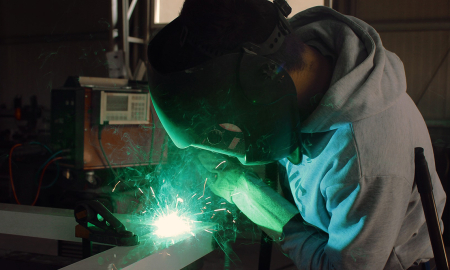Electrified Railways: Measuring Exposure to Electromagnetic Fields
With most of the UK railways electrified, the rail environment has the potential to create high electromagnetic fields (EMFs) as part of its day-to-day operation. All employers are required to assess risks in the workplace and implement control measures to reduce any identified risk – and EMF is no exception to this rule. Therefore, without proper controls in place, the high electrical voltage on the railway has the potential to expose workers to EMFs.
All employers are required to assess risks in the workplace and implement control measures to reduce any identified risk – and EMF is no exception to this rule. Therefore, without proper controls in place, the high electrical voltage on the railway has the potential to expose workers to EMFs.
Electromagnetic fields (EMF) arise whenever electrical energy is used. While domestic appliances produce EMFs at low levels, through computers, TV and radio, some sources in the workplace and in industrial environments can produce EMFs at a higher intensity which can be harmful to employee health. Activities and equipment that can cause EMFs include electric vehicles, electrochemical processes, high voltage power lines and the distribution of electricity, as well as welding.
All employers are required to assess risks in the workplace and implement control measures to reduce any identified risk – and EMF is no exception to this rule. Therefore, without proper controls in place, the high electrical voltage on the railway has the potential to expose workers to EMFs.
Risks of exposure
On the railway, transformer units, engine cabs, overhead cables all have the potential to emit EMFs. However, as EMFs reduce in strength over distance, those in proximity are the ones at risk.
EMFs can cause stimulation of sensory organs, nerves and muscle, as well as heating. All employees need to be protected, but some are classed as being at particular risk, for example expectant mothers and employees with implanted or body-worn media devices, such as pacemakers and artificial joints. Employees at particular risk should be identified before any measurement takes place and personal consideration given towards their particular implant, and whether it is active or passive. EMF exposure can also pose a risk to expectant mothers.
EMFs may also be incidental, for example the fields generated near to the cables distributing electrical power within buildings, or resulting from the use of electrically powered equipment and appliances. Importantly, as most fields are electrically generated, they will disappear immediately when the power is switched off.
Measuring the risks
For EMF exposure monitoring, Action Levels (ALs) and Exposure Limit Values (ELVs) are two sets of values outlined by the Control of Electromagnetic Fields at Work (CEMFAW) Regulations. ELV’s are legal limits but difficult to measure - whereas AL’s have been produced as they can be directly measured using instrumentation.
Conducting EMF risk assessments can ensure that appropriate and suitable control measures are implemented, with the aim of restricting any exposure that may exceed the AL.
If the AL is not exceeded, then exposure cannot exceed the corresponding ELV therefore no further action is required. If the AL is exceeded, an action plan is needed to determine how to mitigate the risk.
What to measure?
An initial EMF scoping study means assessing the appropriate equipment and personnel for measurement. Where any non-compliance equipment is suspected, using Rail Safety & Standards Board (RSSB) “Guidance on the Application of the CEMFAW Regs – June 2016” and the ‘EMF Checklist of Equipment’ from HSE, EMF measurements are taken to further understand the levels in relation to the CEMFAW Regs.
Examples of train equipment potentially exceeding guidance limits include:
- Transformer units
- Electrical equipment and cables inside engine cabs of trains
- Rectifier enclosures
- Motors
- Underframe antennae/readers
- AC and DC electrification, to include conductors, earth wires, power cables,
- Maintenance sheds/pits
With a variety of equipment that may give rise to potentially high levels of EMFs, EMF measurements are therefore taken where relevant to understand these levels in relation to the CEMFAW Regs and expressed as a % of the relevant ALs.
Taking measurements should be done at various positions to determine where the EMFs are at their highest. For example, measurement of EMF exposure from the transformer unit should be taken adjacent to the unit, as well as at head, chest and groin height to measure all scenarios for exposure.
EMF intensity also needs to be included in the risk assessment. Cruising speeds for trains tend to require less power, and emitted EMFs may be weaker. Acceleration – or slowing down – can generate higher frequency and intensity of EMFs as more electricity is required – meaning that any member of staff spending a particular amount of time within the engine cab, for routine checks and maintenance duties, may be at risk of excessive exposure. When risk assessing, it is important that measurements are taken at full power and full current consumption during maximum acceleration to reflect worse-case scenarios to determine when EMF exposure inside the engine cab would be at its highest.
As such, a number of recommendations would be made to limit exposure:
- Employees at particular risk would be restricted from entering or accessing the engine cabs while the train is running or in stand-by mode
- Appropriate EMF warning signage would also be recommended to ensure employees at particular risk are fully aware of the potential EMF hazards inside the Engine cabs
- Educating employees on the potential risks, to keep distance from equipment where practicable
The above approach would be applied to all areas identified that are potentially non-compliant.
If measurements are made and ALs are not exceeded, then risk can be considered low and no further action is required other than regular review. A yearly EMF Risk Assessment review is recommended to ensure the recommendations have been understood and correctly implemented, and to ensure compliance is still valid in case scenarios have changed within this period.
For more information on monitoring EMF exposure, please click here or contact us.






Add new comment